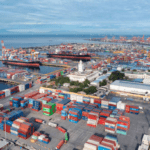- Home
- Trade News
- India Lowering Floor Price for ...

In the aftermath of India’s unprecedented export ban on rice, the nation is now making strategic adjustments to its trade policies to navigate evolving market dynamics. A significant move in this direction is the reduction of the floor price for basmati rice exports. India is set to reduce the floor price for basmati rice exports from $1,200 to $850 per metric ton in response to concerns raised by millers and traders over a significant decline in overseas sales of this premium aromatic grain. This decision comes as a crucial adjustment in the face of evolving trade data and market dynamics.
Last month, Indian authorities had fixed the minimum export price (MEP) for basmati rice shipments at $1,200 per metric ton, with the intention of ensuring that non-basmati rice was not misrepresented and exported as basmati rice.
India’s decision to reduce the floor price for basmati rice exports from $1,200 to $850 per metric ton can be attributed to several strategic reasons:
Competitiveness in the Global Market: The high minimum export price (MEP) of $1,200 per metric ton made Indian basmati rice less competitive in the international market. Lowering the MEP to $850 enhances the price competitiveness of Indian basmati rice, making it more attractive to buyers worldwide. This move is essential to maintain and potentially increase export volumes.
Falling Trade Data: The decision also reflects the concern over falling trade data and overseas sales of basmati rice. By reducing the floor price, India aims to boost exports and address the challenges posed by declining sales, which have been affecting farmers and traders in the basmati rice sector.
Preventing Market Glut: With the new crop season approaching, there was a risk of India facing a surplus of premium basmati rice. A surplus could lead to a glut in the market, driving down prices and negatively impacting both farmers and the broader Indian rice sector. Lowering the MEP helps balance supply and demand dynamics and avoids such a scenario.
Supporting Farmers: India’s agricultural sector is vital to its economy, and many farmers rely on rice cultivation for their livelihoods. Falling exports and prices were hurting farmers. By reducing the MEP, India aims to support farmers by stabilizing their income and ensuring they are not adversely affected by the export ban.
Maintaining Market Dominance: India and Pakistan are the exclusive growers of premium aromatic basmati rice globally. India’s basmati rice is highly regarded for its quality and aroma. By adjusting the floor price, India aims to maintain its dominance in the global basmati rice market and continue exporting to key markets such as Iran, Iraq, Yemen, Saudi Arabia, the United Arab Emirates, and the United States.
The move to lower the MEP for basmati rice is welcomed by industry experts and stakeholders. According to Prem Garg, President of the Indian Rice Exporters Federation, this adjustment will not only alleviate the financial strain on farmers who were suffering from decreasing exports but will also bolster India’s standing in the global basmati rice market.
An important aspect to consider is that basmati rice is not a staple in India’s domestic consumption patterns. Moreover, with the new crop season set to begin shortly, India could have faced a surplus of premium basmati rice, leading to a potential glut in the market. This, in turn, could have exerted significant downward pressure on prices and adversely affected both farmers and the broader Indian rice sector.
India and Pakistan remain the exclusive growers of premium aromatic basmati rice globally. India, in particular, exports approximately 4 million tons of basmati rice to several countries, including Iran, Iraq, Yemen, Saudi Arabia, the United Arab Emirates, and the United States.
In conclusion, India’s decision to reduce the floor price for basmati rice exports underscores its commitment to adapt to changing trade realities. This adjustment not only bolsters India’s competitiveness in the global rice market but also supports farmers and the crucial basmati rice sector. It positions India to navigate the post-export ban landscape effectively while maintaining its influential role in the global basmati rice trade.
Explore individual rice topics further. Click here to read more.
- Vietnam’s Rice Exports Outshine Thailand’s: Discover how Vietnam’s rice industry is outpacing its regional counterpart and making waves in the global market.
- Vietnam’s Rice Industry Adapts to Global Demand Surge: Explore how Vietnam’s rice sector is evolving to meet the increasing global demand for this staple food.
- Vietnam’s Rice Thrives Amid India’s Export Restrictions: Learn how Vietnam’s rice trade is thriving, even as India imposes export restrictions, reshaping the global rice market.
- Thailand: Balancing Rice Prices and Water Resources: Delve into Thailand’s strategy for balancing the rice industry in the face of changing rice prices and water resource management.
- Thailand Benefits from India’s Rice Export Ban: See how Thailand is reaping the benefits of India’s rice export ban and solidifying its position in the international rice trade.
- Navigating Food Supply Challenges in Southeast Asia Amid India’s Rice Export Ban: Get insights into how Southeast Asian countries are navigating food supply challenges caused by India’s rice export restrictions.
- India’s Rice Export Ban and Global Food Security Concerns: Understand the implications of India’s rice export ban on global food security and its impact on trade dynamics.
- India Bans Rice Exports, Boosting China’s Rice Trade with Ivory Coast to Record Highs
The most trustable and reliable source for Trade Data.
TradeData.Pro is a reliable and trustworthy source of trade data proudly made in Singapore, a country known for its stable political climate and trade-driven economy. Presented by Commodities Intelligence Centre, a government-linked company and a joint venture of Zall Smartcom, SGX, and GeTS, TradeData.Pro has received positive feedback from the market since its launch in 2018 for its extensive coverage, affordability, and fast response. The platform has been awarded the Singapore Quality Class in 2020 and the Stevie Award Gold in 2021.
Traditionally, obtaining critical data to reveal trends, identify market opportunities, track competitors, buyers, and suppliers, and better understand the potential of the supply chain has been a challenge. However, the detailed shipment information that is part of government import and export filing requirements does exist and forms the core of global trade. TradeData.Pro has gathered and packaged this information as business intelligence, which helps companies understand the flow of goods across borders and features the world’s largest searchable trade database. TradeData.Pro reviews, standardizes, and cleans data and delivers it in an intuitive format, making it easier for businesses to access.
Businesses interested in staying updated on Vietnam, the hottest industry lately, can access all relevant information on the TradeData.Pro platform. They can find the exact product they’re interested in by checking out the trade database demo at https://tradedata.pro/asia-trade-data/vietnam-import-export-data/. To learn more about accessing new markets, visit https://tradedata.pro/trade-database-demo/.
Additionally, businesses can check out this article to learn how to use TradeData.Pro to access Global Trade Markets: https://blog.tradedata.pro/v3-new-upgrade-of-world-leading-global-trade-data-platform/. To understand how TradeData.Pro works, watch the video below or visit https://www.youtube.com/watch?v=tITfUvjs6Gc
Business Economy Export Import India International Trade Markets Opportunities Rice Supplier Worldwide
Recent Posts
Archives
- May 2025
- April 2025
- March 2025
- February 2025
- January 2025
- December 2024
- November 2024
- April 2024
- March 2024
- January 2024
- December 2023
- November 2023
- October 2023
- September 2023
- August 2023
- July 2023
- June 2023
- May 2023
- April 2023
- March 2023
- February 2023
- January 2023
- December 2022
- November 2022
- October 2022
- September 2022
- August 2022
- July 2022
- June 2022
- May 2022
- April 2022
- March 2022
- February 2022
- January 2021
Categories
Recent Post
Forecasting a Brighter Outlook for Chile Imports
- May 30, 2025
- 8 min read
Italy Imports More Gas, Less Textiles and
- May 2, 2025
- 9 min read
Strategy-Driven Upward Trends for Exports of the
- May 2, 2025
- 13 min read
All Tags
Agriculture Automotive Brazil Business Business Opportunities Buyers China Coffee Commodities Crops Ecommerce Economic Economy Electronics Energy Environmental Europe Export Exports Future Garments Global Import India Industries International Trade Leads Leads Generation manufacturing Markets Opportunities Pharmaceuticals Prices Rice Russia Supplier Textiles Trade Trade Data Trade Data Pro Turkey Ukraine United States Vietnam Worldwide








